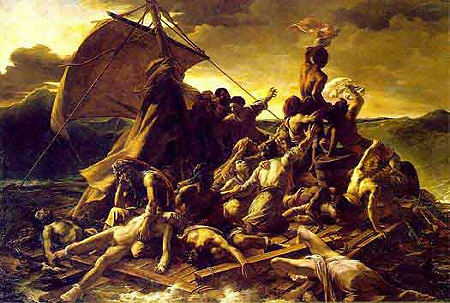 |
| The Raft of the Medusa by Théodore Géricault 1791-1824 Completed 1819, oil on canvas. 16 x 23ft. (it's big!) |
This painting
is possibly more interesting for it's non-art elements than for the art work
itself. In 1818 Théodore Géricault was a young man trying to build an
artistic reputation but the innovation of this work is that it depicted a recent, true event.
'History
painting' is a genre in art that was dominant from the sixteenth century. It
was intended to have moral or didactic overtones and usually depicted stories
from the Bible, mythology or literature. It was only history in
the sense of having a story or narrative and usually depicts a certain single
point from that narrative. These paintings were often very large and this one
is on a larger-than-life scale. It was viewed as the most important genre at
that time and seen as the pinnacle of an artist's career.
In 1816 the French frigate Méduse
ran aground off the coast of Senegal. The story that followed was one of 15
survivors left on a hurriedly constructed raft after 13 days at sea
experiencing starvation, dehydration and....cannibalism. There was political outrage
because an inexperienced captain had been appointed through his good
connections rather than his skill.
Géricault had
conducted extensive research before starting to paint and had
visited morgues to get the decaying flesh tones right. His scheme worked and
the controversial first showing of this painting in
Paris catapulted him to fame and it was soon shown in London
with similar success. It greatly divided the critics some of
whom did not want to be 'repelled' by a 'heap of bodies' and thought that this
could not be art.
On the other hand he was praised (by others) for showing a negro at the
focal point of the picture. The triangular composition raising upwards to the
right indicating the hopes of the survivors as a distant ship is seen on the horizon.
The ship didn't see them and passed by. I think I can just
make out a tiny point on the horizon. Earlier studies for the painting do
clearly show a large vessel .
There were ten survivors from the Méduse. Géricault
died five years later at the young age of 32. His painting lives on as an icon
of French Romanticism.
| You can just about see the ship on the horizon in this detail.
I'm listening to the adagio from Khatchaturian's Spartacus played by the London Symphony Orchestra also known as the Theme from The Onedin Line. Listen here.
|
8 comments:
Hi Bazza - what an amazing painting ... also the interesting story of Gericault - he was obviously an incredibly talented painter ... so sad to lose him so young (32) ... thanks for reposting this - I've been sent off to learn more. Take care - Hilary
Hello Bazza, Sensational paintings like this are always good to cause a stir and earn a reputation. The very name Medusa adds to the horror. It is too bad that Géricault did not live long enough to paint the Donner Party.
--Jim
Hilary: The story is indeed gripping. That the painting is brilliant is an added bonus!
Jim: I'm not too sure that an exciting painting could have been made of The Donner Party!
(I had to Google it because it's not generally known in the UK.)
When the written chronicles about a historical event are a bit limited, I will often use paintings, prints or sculptures to add more information about that event. I acknowledge that the images almost always depicted single, biased points of view, just as the texts did. After all, who would trust an army general, an archbishop or a royal prince to commission an unbiased work?
Hi again, The Donner Pass and Donner Lake are ruggedly beautiful, and tossing in a fierce winter blizzard, I am sure that some Gericault-like painter could have found plenty of drama in the scene. Even with Mrs. Hemans' Casabianca (The boy stood on the burning deck...) and the Wreck of the Hesperus as inspiration, shipwreck paintings couldn't garner all the excitement!
--Jim
Hels: It's a 'History is always written by the winners' thing, I suppose. But one might
want to say that this artist was being a bit cynical in that he set out to make the biggest splash possible by using what was a current well-known topic and making a monumentally-sized piece of art.
Jim: I have done a bit of reading on that topic now. Cannibalism is, thankfully, rare enough for it to always be a talking point.
Post a Comment